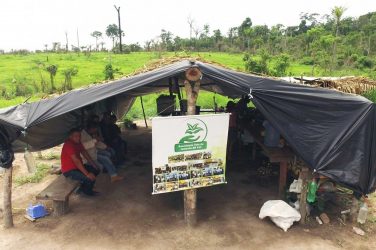Thousands of people benefited from actions to deliver supplies and provide transportation and first aid for more than 20 days to two Brazilian states affected by intense rains.
Pernambuco and Alagoas are two northeastern states in Brazil that usually suffer from long periods of drought. Since the end of May, the scenario has been different. Heavy rains led local authorities to declare a state of emergency in 50 cities. Floods and mudslides affected more than 48,000 people. Of those, nearly 3,000 lost their homes.
The disaster prompted Brazil’s Ministry of Defense to ask the Armed Forces to help those in need. Members of the Brazilian Navy (MB, per its Portuguese acronym), and the Brazilian Air Force (FAB, per its Portuguese acronym), concentrated on the deployment of people and the transport of supplies, and joined the Brazilian Army (EB, per its Portuguese acronym) in the work coordinated by the latter in two field hospitals.
The city of Rio Formoso in the state of Pernambuco was the first to receive one of the field hospitals, since the water had flooded the municipal hospital, resulting in lost equipment and hampering operations. From June 2nd to 5th the city’s population only had the assistance offered by 34 Armed Forces professionals who worked there.
Another hospital was set up in Marechal Deodoro in the state of Alagoas, where the rains mainly caused damage in the historical town center, which remained partially submerged, accessible only by canoe.
The EB structure set up in this town helped three more municipalities and also involved 34 service members. They were deployed on June 23rd, once the activities of the region’s health institutions returned to normal.
“Each field hospital has 10 barracks, and doctors, nurses, pharmacists, and nurse technicians, including service members from the Brazilian Army, Navy, and Air Force,” said Brazilian Army Colonel Maria Sandra Andrade, from the Health Inspector’s Office of the 7th Military Region in Pernambuco, and coordinator of the Field Hospital for the Northeast Military Command.
The barracks used measured 48 square meters each. The combination of a dozen of these structures allows the hospitals set up in Rio Formoso and Marechal Deodoro to have a triage and welcome section, a room for urgent and emergency care, outpatient clinics to attend four patients simultaneously, a nursing center, and a pharmacy.
An observation section, where patients stayed for up to 24 hours, and a section to perform procedures such as suturing, bandaging, administering drugs, and applying splints to fractures was also set up.
Additionally, the field hospital in Rio Formoso has a laboratory for tests and clinical analysis not found at the Marechal Deodoro structure. The latter, by way of compensation, had X-ray machines that were not available to the other city.
In the two hospitals, the main complaints directly related to the floods were vomiting, diarrhea, fever, and respiratory complications.
“Many problems were caused by contact with contaminated water, difficulty storing food, and the isolation of some communities,” explained Col. Sandra. She also recalled cases of anxiety attacks in those in shock over the loss of their possessions, their homes, and even loved ones.
“This type of mission is very sensitive because the people receive serious cases and simple cases, but they are all involved in the complexity of an emergency situation due to the storms,” she stated.
In the Marechal Deodoro hospital, around 450 people received assistance during 19 days of operation. In Rio Formoso, that number rose to approximately 3,000 people, according to a survey conducted June 29th, a week before the structure started to be dismantled.
Among the many incidents that marked the emergency mission, one stood out. On June 8th, an 18-year-old woman arrived at the Rio Formoso field hospital ready to give birth.
The delivery was performed by a civilian doctor, who was a member of the team, with the aid of a military pediatrician, who was responsible for first aid and evaluation of the infant.
“Everything went very well. They baby was very healthy and the mother remained calm. It was a special moment for everyone,” recalled Col. Sandra.
Deployments and Transport of Supplies
FAB deployed 12 airmen from the Rio de Janeiro-based Puma Squadron to the mission in Pernambuco and Alagoas. The team employed an H-36 Caracal helicopter to carry food, water, and other supplies to the areas most affected by the rains, as well as to transport the homeless.
MB’s participation had the same goal. Ten service members were deployed in a UH-15 helicopter from the 2nd General Use Helicopter Squadron, also based in Rio de Janeiro.
The Crisis Cabinet located in Recife, the capital of Pernambuco, was in charge of coordinating the assistance offered by the armed forces and other governmental agencies.
“As for the flights, the coordination was done between the cabinet, the Navy, and the Air Force between 8:00 am and 6:00 pm every day,” reported Rear Admiral Flávio Augusto Viana Rocha, the director of the Navy’s Social Communication Center.
“The Armed Forces are characterized by the capacity to mobilize, work together, and the unending search for the common good,” he added.
Members of the 15th Wing, an operational unit of FAB based in Recife, were also partnered with a non-governmental organization from that city and participated in the triage of the wounded, separating supplies, and loading the trucks with the donations that were delivered to the population in the most critical regions.
This article appeared originally in Diálogo – https://dialogo-americas.com/en/home














